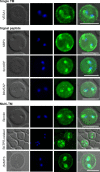Advances in understanding red blood cell modifications by Babesia
- PMID: 36107982
- PMCID: PMC9477259
- DOI: 10.1371/journal.ppat.1010770
Advances in understanding red blood cell modifications by Babesia
Abstract
Babesia are tick-borne protozoan parasites that can infect livestock, pets, wildlife animals, and humans. In the mammalian host, they invade and multiply within red blood cells (RBCs). To support their development as obligate intracellular parasites, Babesia export numerous proteins to modify the RBC during invasion and development. Such exported proteins are likely important for parasite survival and pathogenicity and thus represent candidate drug or vaccine targets. The availability of complete genome sequences and the establishment of transfection systems for several Babesia species have aided the identification and functional characterization of exported proteins. Here, we review exported Babesia proteins; discuss their functions in the context of immune evasion, cytoadhesion, and nutrient uptake; and highlight possible future topics for research and application in this field.
Conflict of interest statement
The authors have declared that no competing interests exist.
Figures





References
-
- Smith T, Kilborne FH. Investigations into the nature, causation, and prevention of Texas or southern cattle fever. Bull of Bureau of Anim Ind. U.S. department of Agriculture, Washington, 1893:1
Publication types
MeSH terms
LinkOut - more resources
Full Text Sources

